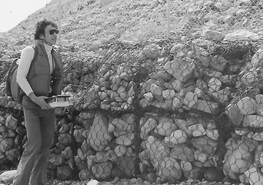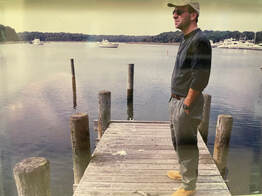 Montauk Point, 1978
Montauk Point, 1978 I am standing between the Atlantic Ocean and Montauk Point, literally. Above me on top of the bluff is the Montauk lighthouse, sitting on the location selected when George Washington was president. That location then, was 300 feet from the bluff and at that time, the end of Long Island. In 200 years, just over 200 feet has eroded away. The Montauk lighthouse that was built in 1796, the first public works project of the new United States of America, was only 90 feet away from falling into the sea in 1978. Mother Nature's Long Shore Drift pitted Nature against Human and humankind was losing. A long term solution was needed fast to save the old historical lighthouse.
My fellow students and I all came well prepared, I had my Boys Scout backpack that was well stocked, binoculars and compass was around my neck. I carried reference books (no internet at that time), a clip board and the just becoming vogue ski vest. Our task was to save the point of Long Island's south fork from eroding away and subsequently save the light house. If not, we would lose land and the lighthouse to the ragging sea. My fellow students and I were determined to find an answer while evaluating all factors westward along the shoreline that are involved with the Long Shore Drift. At the conclusion of our field trip and study, we felt defeated.
Many actions were already taken by humans over the years and all failed or were failing. The system that I was observing in 1978 had thousands of rocks held together in wire netting. The system wasn't going to last. Even giant boulders were placed at the point prior to my field trip and in a hurricane, when the waves pounded the point, local residents could hear the boulders banging against each other like marbles in a bag being swung around. I witnessed the remnants of the boulders as the tide receded. The situation looked hopeless. The only solution to save the lighthouse was to start a major fund raiser and move the lighthouse westward. However, the move entailed going up and down two hills, this wasn't feasible.
What we undergraduates did not know at the time, was the fact that a tenacious woman in her seventies was already working on a long term solution for years. This "individual" named Giorgina Reid was researching an action called reed-trench terracing. Some of the techniques go back to the ancient Egyptians. She wanted to use cedar planks as risers and at each level trenches were dug out to be filled with reeds. This prevented rain from building up as the reeds absorbed the moisture. Stacked stones held tight in square grid formation by coated wire to prevent rust would sit on each level. However, she was unable to gather the attention of anyone for help with her solution, until a few years after my visit to Montauk's lighthouse. She corresponded with another individual, President Ronald Reagan and the wheels for a long term solution started to turn. After full implementation of Giorgina's solution, the erosion at the point stopped.
 Studying Plastic Pollution In Our Waterways
Studying Plastic Pollution In Our Waterways As for my Boy Scout backpack, I will be donating that with my uniform and equipment to my old Troop 22 so Scouts of today can compare then and now. My gear is made in the USA with metal and cotton, today's gear is made of plastic and comes from China.
(For additional facts on plastic in our clothes, air, waterways, food and drink, read my Previous GTG Blog)
I still have my binoculars, compass, text book and clip board. The scary part is... I still have that ski vest, but I don't have as much hair anymore.
Bill Lauto, at GoingTrueGreen.com
Environmental Scientist
International Sustainability and Energy Consultant
Contribute your comments!





















